Meze headphone review
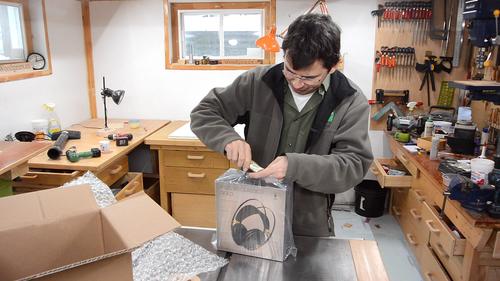 Meze headphones first contacted me in June of 2015 about
doing a giveaway of a few pairs of their "wooden" headphones. But I'm not
really into that sort of thing. I certainly find it annoying when others
do these giveaways. I never buy lottery tickets, and I never find it worth
jumping through hoops for a slim chance at a freebie. So I didn't see much
value in it and declined.
Meze headphones first contacted me in June of 2015 about
doing a giveaway of a few pairs of their "wooden" headphones. But I'm not
really into that sort of thing. I certainly find it annoying when others
do these giveaways. I never buy lottery tickets, and I never find it worth
jumping through hoops for a slim chance at a freebie. So I didn't see much
value in it and declined.
In November that same year, they contacted me about their new over-the-ear headphones, the Meze 99 Classics, and asked whether I would be interested in doing a review.
With a new baby in the house and Rachel sometimes practicing her singing, having a good pair of headphones for video editing is more of a priority. But I'm still not very keen on promoting products, so I offered to do a review on my other YouTube channel with far fewer subscribers. Surprisingly, they still agreed and sent me a pair.
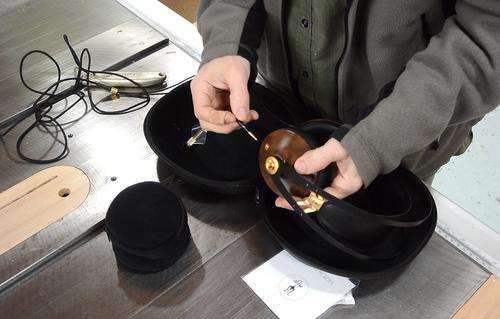 I received the headphones in early 2016. They are very substantial.
Each ear piece has a
separate 3.5 mm jack that the cables plug into. It comes with two cloth
wrapped sets of cables, one with a click button to control a smartphone
with, the other without. Both are quite long.
I received the headphones in early 2016. They are very substantial.
Each ear piece has a
separate 3.5 mm jack that the cables plug into. It comes with two cloth
wrapped sets of cables, one with a click button to control a smartphone
with, the other without. Both are quite long.
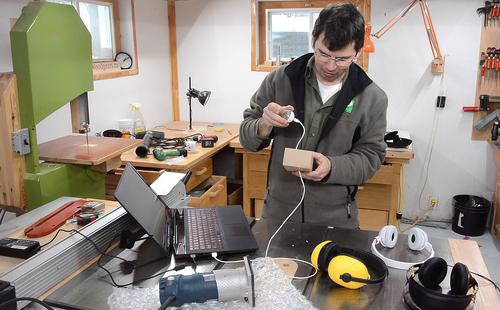 The cups on the headphones don't have any holes in them and isolate the
sound quite well. So I thought I'd try to measure the isolation. My first thought
was to maybe put a small microphone inside the cup and then put them on
my head. But I didn't have a suitable microphone that worked with my
computer. So my next thought
was to just use my Blue Snowflake microphone in a block of wood.
I drilled a cavity just big enough, with a small hole out the back for
the cable. As a noise source, I used a Bosch Colt router (on the
bubble wrap nearest to the camera).
The cups on the headphones don't have any holes in them and isolate the
sound quite well. So I thought I'd try to measure the isolation. My first thought
was to maybe put a small microphone inside the cup and then put them on
my head. But I didn't have a suitable microphone that worked with my
computer. So my next thought
was to just use my Blue Snowflake microphone in a block of wood.
I drilled a cavity just big enough, with a small hole out the back for
the cable. As a noise source, I used a Bosch Colt router (on the
bubble wrap nearest to the camera).
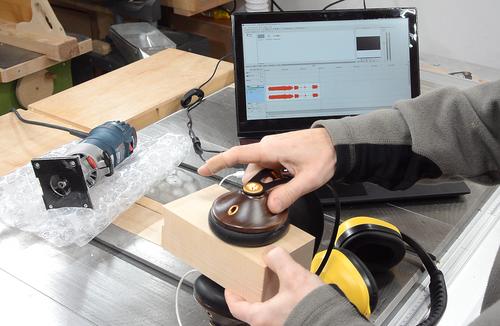 With the Meze headphones, the sound level went down by about 23 dB. My
yellow hearing protection earmuffs did maybe 3 dB better than that.
Though with that much attenuation, sound coming through the wood
itself becomes a factor.
With the Meze headphones, the sound level went down by about 23 dB. My
yellow hearing protection earmuffs did maybe 3 dB better than that.
Though with that much attenuation, sound coming through the wood
itself becomes a factor.
These aren't headphones with active sound cancellation, but it's quite impressive how much they reduce noise.
By comparison, my Sony headphones provided maybe around 6 dB of attenuation. Not very much.
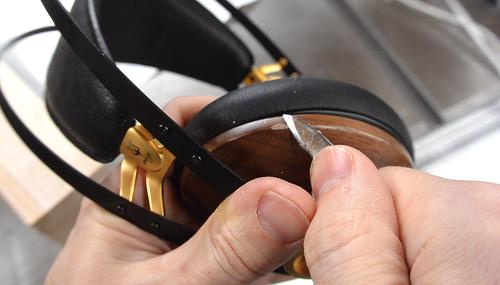 The finish on the ear cups is so smooth, I was starting to wonder "Is it
really wood?" So I scraped off the varnish in one corner, and, sure
enough, under the thick varnish is wood.
The finish on the ear cups is so smooth, I was starting to wonder "Is it
really wood?" So I scraped off the varnish in one corner, and, sure
enough, under the thick varnish is wood.
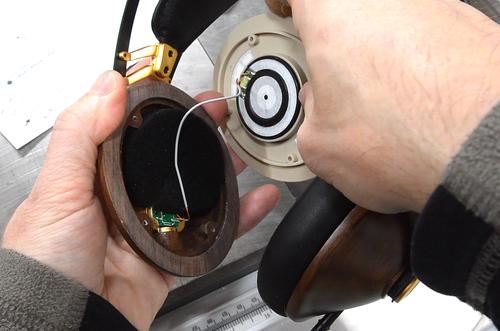 I pulled the padding off one side and opened it up. Definitely wood.
Those ear cups look like they have been milled on a CNC machine.
I pulled the padding off one side and opened it up. Definitely wood.
Those ear cups look like they have been milled on a CNC machine.
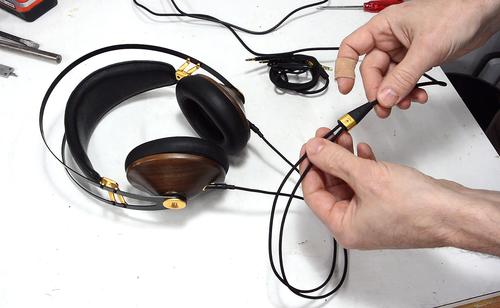 The cords on the headphones are quite long. With the fabric wrap around
the cord, they feel quite nice, but I think it increases the chance of
the cords getting tangled.
The cords on the headphones are quite long. With the fabric wrap around
the cord, they feel quite nice, but I think it increases the chance of
the cords getting tangled.
One thing I don't like very much is the large part that splits the cords in two. The wide edge on it has a tendency to get caught on just about everything.
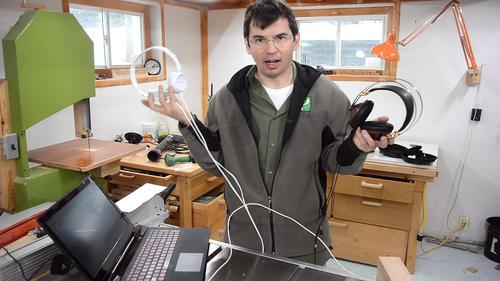 The headphones sound very clear. But I have to say, for listening to
music, I prefer the sound of Sony headphones (I think I paid $30 for them).
The reason is that the bass on the Meze headphones is just too strong. Much
stronger than any other headphones I have tried.
The headphones sound very clear. But I have to say, for listening to
music, I prefer the sound of Sony headphones (I think I paid $30 for them).
The reason is that the bass on the Meze headphones is just too strong. Much
stronger than any other headphones I have tried.
I fussed with the headphones for some time, trying them with some music by Jesse Cook specifically the song "Early on Tuesday" with a very busy bass line, and the bass was just too dominating.
The sound reminded me of experimenting with speaker enclosures. When a speaker is put in a box, you need some padding in the box to prevent the air inside from resonating too much with some frequencies. This makes some bass notes much louder than others.
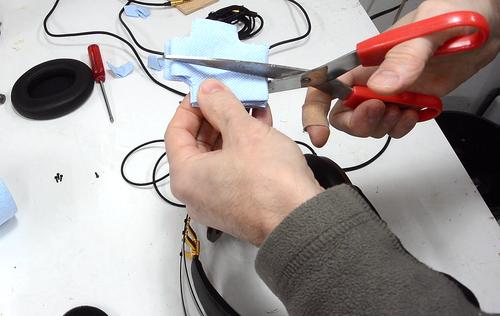 Since I already opened up one side, I figured, no harm in opening it
up again and trying to add some padding. I used some blue shop towel I
had lying around (probably not the best material for the job), folded it
up and made a pad that just fit in the space behind the speaker.
Since I already opened up one side, I figured, no harm in opening it
up again and trying to add some padding. I used some blue shop towel I
had lying around (probably not the best material for the job), folded it
up and made a pad that just fit in the space behind the speaker.
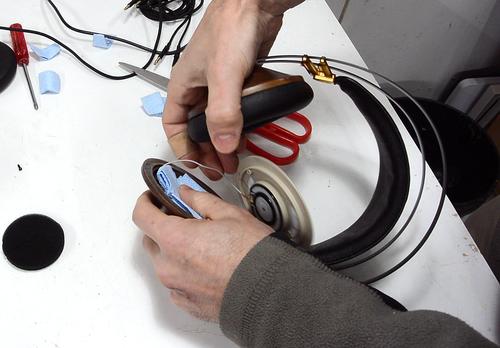 It was tricky to get in, and I ended up stripping one of the small
screws (I wish they used longer screws). But I used my usual trick of
putting a dab of wood glue in the hole and then the screw.
The wood glue sticks to the wood, but not so much to the screw, so the
screw can still be unscrewed after the glue dries.
It was tricky to get in, and I ended up stripping one of the small
screws (I wish they used longer screws). But I used my usual trick of
putting a dab of wood glue in the hole and then the screw.
The wood glue sticks to the wood, but not so much to the screw, so the
screw can still be unscrewed after the glue dries.
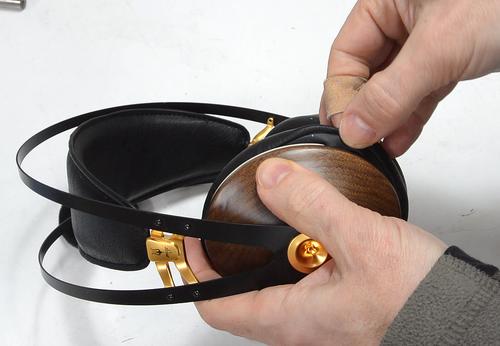 Getting the padding back on is also a bit tricky, but still easier
than getting a bicycle tire on its rim.
Getting the padding back on is also a bit tricky, but still easier
than getting a bicycle tire on its rim.
After that, I tried the headphones. Without checking which side I modified, I listened to the headphones, swapping left and right and seeing with side I liked more (as in, which side is less boomy). Consistently, the side I identified as sounding better was the one I had modified (the only way I could tell was by looking for where I cut away a bit of the varnish earlier). I swapped the plugs for left and right and repeated a few more times to rule out whether it was the music itself that was boomier on one side or the other.
So I think these headphones could use some better damping material behind the speakers. I don't think the little black foam pad that they come with is enough.
When I built my ukulele, it also had some boominess to it in certain notes, and some felt inside the body also cured that.
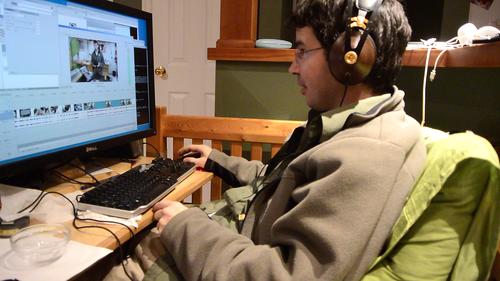 I mostly use these headphones when there is too much noise in the house
while I'm trying to edit videos. With the background sound
level reduced a lot and clearer sound, I can tell the audio quality in
my videos is not as good as it could be.
I mostly use these headphones when there is too much noise in the house
while I'm trying to edit videos. With the background sound
level reduced a lot and clearer sound, I can tell the audio quality in
my videos is not as good as it could be.
But it would be a bad idea to edit video exclusively with headphones. With the lower background noise, the ears too easily adjust to variations in volume (dynamic range), and so it's too easy to make videos where a good listening environment is needed to appreciate them. A good test is to play the video back on the speakers, turned down so it's just loud enough. That way, when there are sounds that should be heard that are significantly quieter, I don't hear them and know these need to be boosted.
Meze has a discount code "MATTHIAS10" that you can use to get 10% off these headphones. Of course, we all know these codes are all about figuring out how many sales come from different social media exposure. But if you do buy them, just use the code :)
These headphones are fairly expensive, and for that money, you may also be able to get some active sound cancelling headphones. And whether you want as much sound isolation may also be a matter of preference. When the house is quiet, I'd prefer to be able to hear what's going on in the room.
I didn't get paid for this review (other than a good pair of headphones, which comes in very handy). I appreciate dealing with the company directly, rather than through an ad agency. And they were cool with the video, even though I'm critical of the sound. I spent more time than anticipated on it, and the results were more interesting than anticipated, so I figured it was interesting enough to put on my main YouTube channel after all. It's also not the first time I reviewed something in exchange only for product. I previously did that with the LED lights in 2015 and the Wagner moisture meter in 2012.
See also:
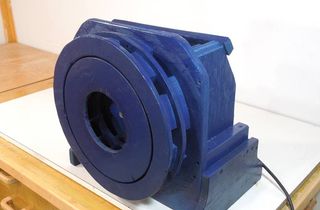 Building an air raid siren
Building an air raid siren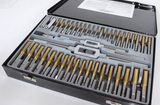 Reviewing "Maximum" tool bag and tap and die set (sponsored content)
Reviewing "Maximum" tool bag and tap and die set (sponsored content)To my Woodworking website.
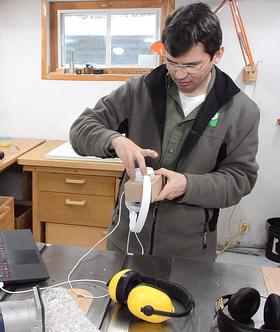
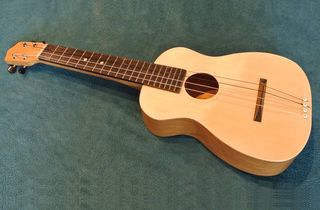 Building a ukulele
Building a ukulele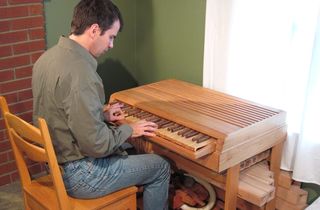 Homemade pipe organ
Homemade pipe organ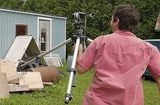 The steadycam you already own
The steadycam you already own LED vs CF
LED vs CF